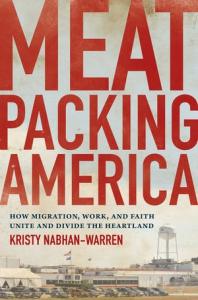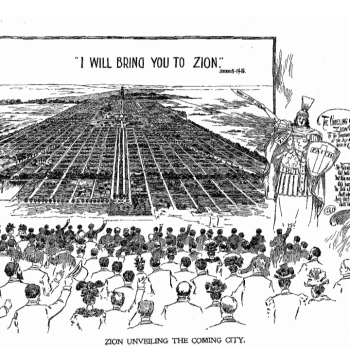Sometimes it seems that Americans are unusually good at hating each other. Red/blue, secular/evangelical, vaxxed/anti-vaxxed, you name it, we go at it. Media outlets of many stripes promote feed these tropes and stoke these fires. And although I mostly use it to chat about new academic books, everyone tells me that social media is a cesspit of hatred and abuse.
 And yet. Most of us aren’t full of hate, even for those who have different opinions about masks and vaccines. Most of us aren’t all that bad at getting along with our neighbors, or at least peacefully co-existing with them. There is plenty of reason for hope and optimism.
And yet. Most of us aren’t full of hate, even for those who have different opinions about masks and vaccines. Most of us aren’t all that bad at getting along with our neighbors, or at least peacefully co-existing with them. There is plenty of reason for hope and optimism.
And nuance. Scholars love nuance, but other people should embrace it as well. I recently profiled Nicholas Pruitt’s book about Protestants and immigration in the twentieth century. In addition to documenting the wide range of shifting views that white Protestants held about immigration and immigrants, Pruitt showcased mainline ministries that took seriously Jesus’s command to welcome the stranger.
What about today? In her thoughtful and moving Meatpacking America, Kristy Nabhan-Warren scratches beneath the surface of Red State, small-town America to tell a story that is both sobering and encouraging. She takes seriously two groups of Americans. First, those refugees “who have migrated and settled and who persist, despite many odds, in many lives for themselves in the midwestern Corn Belt.” One point of necessary clarification. She refers “to all of the brown and Black women and men who come to America for a better life as refugees, whether or not they have officially been granted the status of refugee by the U.S. Government.” They are fleeing poverty, violence, and death. Her other subjects are “people who have been overlooked and stereotyped by mainline media: white Iowans.” Indeed, both groups are the frequent subjects of caricature and derision.
I especially like the way that Nabhan-Warren frames the “sticky wicket of whiteness.” Many of her white subjects tolerate “the presence of refugees in their community,” but they simultaneously “wish things could be what they imagine as ‘the way they were before’ – white and predictable.” As she says, this sort of racial nostalgia coexists with the “belief that whiteness is superior,” but Nabhan-Warren concludes that the perspective of midwestern white people deserves more careful attention. They voted for Donald Trump and others who espoused hateful rhetoric, but they themselves “are not the angry white racists that their votes would suggest.”
Meatpacking America is not for the faint of heart. Nabhan-Warren – who reveals that she’s been a vegetarian for thirty years – spent a week shadowing workers at Iowa Premium Beef in Tama, Iowa. This fieldwork produced the book’s most moving and heart-rending chapter. Her observations began with the inspection of newly arrived living cattle and their slaughter:
It felt like a holy moment. I found myself whispering a soft prayer of thanks to this creature, whose life was being taken to feed people. Tears rolled down my face, and I felt my throat constrict out of sympathy and empathy for this animal. Its meat would end up on a plate somewhere, and I prayer that whoever tasted this steer’s or heifer’s meat would give thanks too.
Nabhan-Warren’s discussion of the plant’s blood, guts, and stench are stomach-turning, but her assessment of its workers – white, Latino, Congolese, Vietnamese – are inspiring. The workers “resemble meat ninja warriors – sawing, slicing, cutting, and packaging in precise, clean measures.” In particular, she corrects the notion that meatpacking is “unskilled work.” “This is highly skilled work,” she informs. It is also very hard work. “Most white collar professional women and men I know,” she notes, “would have a very difficult time performing the work that is done at plants like IPB.” What a shame it is that many Americans dislike and resent the immigrants and refugees who do this hard work.
Nabhan-Warren also spent time visiting churches in rural Iowa. She attended the parish of Saint Joseph in Columbus Junction for a year. It is a snapshot of Catholic parishes in many parts of the country: a dwindling number of worshipers at the English-language mass, and a bursting crowd at the Spanish-language mass. Joseph Sia, a Filipino American priest, presides over both groups, who rarely intermingle with each other. (One of my favorite details in the book is about a white American priest, Bernie Weir, who, after struggling to communicate with his Spanish-speaking parishioners, spent two weeks in a language school in Guadalajara run by the Sisters of Humility). Latino Catholics are the salvation of these parishes, but salvation sometimes feels like displacement to the white parishioners who themselves used to be religious outsiders in largely Protestant communities.
But Nabhan-Warren also finds and analyzes religion outside of church buildings. It is in the homes of Latino refugees who pray to the Virgin to keep their families safe. It is in a small corner of a meatpacking plant where two Sudanese women put down their prayer rugs five times a day – when supervisors permit – and transform “a gruesome place into a beautiful place.” She also attends to the evangelical-inflected talk of “servant leadership” and paternalism espoused by meatpacking management, where CEOs, supervisors, and chaplains urge their employees to “celebrate their faith” at work. She profiles Joe Blay, a Congolese-born AME chaplain at Tyson Fresh Meats in Columbus Junction. Tyson employs 115 chaplains in its many factories, who are “working hard to make a profoundly profane place … into a sacred place.”
At the outset of Meatpacking America, Nabhan-Warren shares that her book “started out as focused on white Catholics and Latino Catholics and became a more layered and complex story of women and men seeking refuge in Iowa.” Still, I wonder how an ethnography of Corn Belt evangelicalism would be both similar and different from the largely Catholic stories that she tells. Do white evangelical Iowans have different views of immigrants and refugees than their white Catholic counterparts? Nabhan-Warren spent time in parishes in which white and Spanish-language parishioners were sharing buildings, even if they were attending separate masses. How often do white and Latino – or African – evangelicals share sacred spaces? Or worship together?
Meatpacking America ends with the author’s fervent hope “that we are able to come to a point in our country where whites become not merely tolerant or even comfortable with the new demographic realities but accepting of the new American pluralism and all of the beauty and joy it brings to our communities. The communities where refugees live owe much of their prosperity to the hard work that these women and men do for rural America and the U.S. economies. Instead of vilifying them, we should be thankful for their presence and for the many ways they enrich our houses of worship, schools, and community at large.” Amen.












